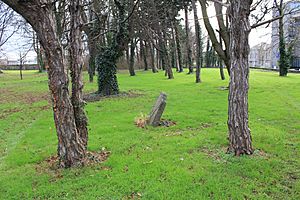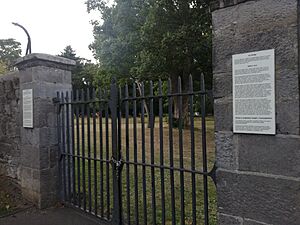Bully's Acre, Dublin facts for kids
Bully's Acre is a very old cemetery in Dublin, Ireland. Its official name is the Hospital Fields, and in Irish, it's called Acra an Bhulaí. This historic place is about 3.7 acres (1.5 hectares) big. It is located near the Royal Hospital Kilmainham.
Contents
What's in a Name?
The name "Bully's Acre" has a few possible meanings. Some people think it got its name because it was a place where boxing matches happened. Imagine people gathering to watch fights there! Another idea is that the name comes from "baily," which was a nickname for the officials who worked at the nearby priory (a type of monastery).
A Long History
There has been a graveyard on this spot for over 1,000 years. That's a really long time! It's even believed that some people who died in the famous Battle of Clontarf were buried here. This includes a son and a grandson of Brian Boru, a very important ancient Irish king.
Over time, Bully's Acre became well-known as a place where poor people could be buried for free. Many believed the land was common ground, so there were no charges for burials. But it wasn't just for the poor. After the English Reformation, when there were no official Catholic graveyards in Dublin, many Catholic citizens also chose to bury their loved ones here.
Gatherings and Fun
In the past, especially on special feast-days, the cemetery was a popular spot for people to gather and socialize. Sometimes these gatherings got a bit wild, with lots of noise and even fights. The biggest event was the "pattern" on the feast of St. John (June 24th). Thousands of people would walk through the cemetery to visit St. John's Well, which was across the road.
Both the Catholic Church and the government tried to stop these large gatherings, but they weren't successful for a long time. They finally managed to stop them in the 1830s, after a serious sickness called cholera spread through the city.
A Battle for the Graves
Around 1760, a military leader named General Dilkes tried to change the cemetery into a garden for the Royal Hospital Kilmainham. He had the graves flattened and covered the area with a thick layer of lime. He also built a tall wall around the place.
However, the local people from an area called the Liberties were very upset. They felt that their ancestors and relatives buried there were being disrespected. So, one night, a large group of them gathered and had a big fight against the soldiers from the Royal Hospital. In the end, the wall was knocked down, and the area was returned to being a cemetery.
Closing the Cemetery
Towards the end of the 1700s, the cemetery started to fall into disrepair. It also became a target for "body snatchers" – people who would dig up bodies to sell them for medical study. This was because the walls around the cemetery weren't very high, even though there were watchmen.
During the cholera outbreak in 1832, many people died, and a huge number were buried here. One writer said that 3,200 burials happened in just six months during that time. Because it was so crowded, the government ordered the cemetery to be closed shortly after. By then, new cemeteries like Goldenbridge and Glasnevin were available for Catholics.
It's thought that hundreds of thousands of people were buried in Bully's Acre over its long history.
Famous Burials
One well-known person buried here was Dan Donnelly (1788–1820). He was a very famous Irish boxer. He was buried in an unmarked grave in 1820. Sadly, his body was later taken by body snatchers and sold to a surgeon in Dublin. The surgeon was asked to return the body, but he first removed Donnelly's right arm. For many years, this arm was displayed in a pub called the Hideout in Kilcullen, County Kildare.
Images for kids




